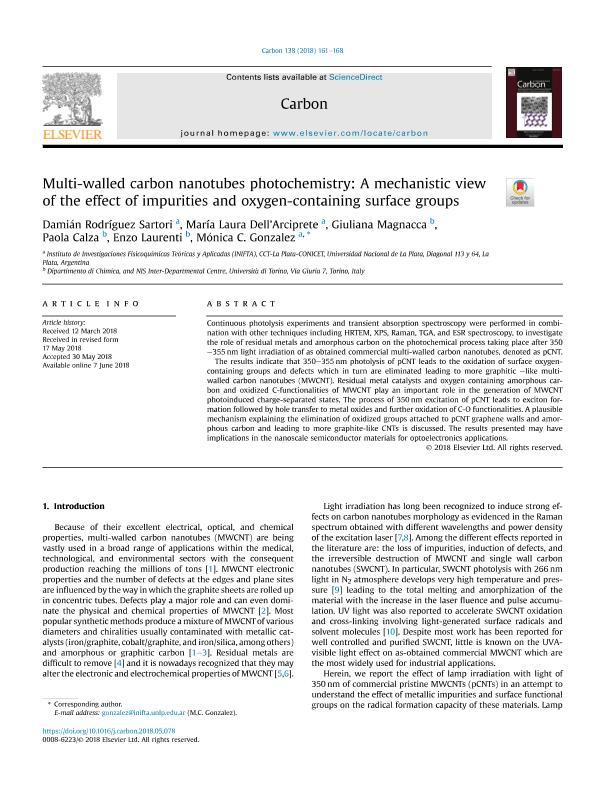Artículo
Multi-walled carbon nanotubes photochemistry: A mechanistic view of the effect of impurities and oxygen-containing surface groups
Rodriguez, Damian ; Dell'arciprete, Maria Laura
; Dell'arciprete, Maria Laura ; Magnacca, Giuliana; Calza, Paola; Laurenti, Enzo; Gonzalez, Mónica C.
; Magnacca, Giuliana; Calza, Paola; Laurenti, Enzo; Gonzalez, Mónica C.
 ; Dell'arciprete, Maria Laura
; Dell'arciprete, Maria Laura ; Magnacca, Giuliana; Calza, Paola; Laurenti, Enzo; Gonzalez, Mónica C.
; Magnacca, Giuliana; Calza, Paola; Laurenti, Enzo; Gonzalez, Mónica C.
Fecha de publicación:
11/2018
Editorial:
Pergamon-Elsevier Science Ltd
Revista:
Carbon
ISSN:
0008-6223
Idioma:
Inglés
Tipo de recurso:
Artículo publicado
Clasificación temática:
Resumen
Continuous photolysis experiments and transient absorption spectroscopy were performed in combination with other techniques including HRTEM, XPS, Raman, TGA, and ESR spectroscopy, to investigate the role of residual metals and amorphous carbon on the photochemical process taking place after 350–355 nm light irradiation of as obtained commercial multi-walled carbon nanotubes, denoted as pCNT. The results indicate that 350–355 nm photolysis of pCNT leads to the oxidation of surface oxygen-containing groups and defects which in turn are eliminated leading to more graphitic –like multi-walled carbon nanotubes (MWCNT). Residual metal catalysts and oxygen containing amorphous carbon and oxidized C-functionalities of MWCNT play an important role in the generation of MWCNT photoinduced charge-separated states. The process of 350 nm excitation of pCNT leads to exciton formation followed by hole transfer to metal oxides and further oxidation of C-O functionalities. A plausible mechanism explaining the elimination of oxidized groups attached to pCNT graphene walls and amorphous carbon and leading to more graphite-like CNTs is discussed. The results presented may have implications in the nanoscale semiconductor materials for optoelectronics applications.
Palabras clave:
CARBON NANOTUBES
,
PHOTOCHEMISTRY
,
IMPURITIES
Archivos asociados
Licencia
Identificadores
Colecciones
Articulos(INIFTA)
Articulos de INST.DE INV.FISICOQUIMICAS TEORICAS Y APLIC.
Articulos de INST.DE INV.FISICOQUIMICAS TEORICAS Y APLIC.
Citación
Rodriguez, Damian; Dell'arciprete, Maria Laura; Magnacca, Giuliana; Calza, Paola; Laurenti, Enzo; et al.; Multi-walled carbon nanotubes photochemistry: A mechanistic view of the effect of impurities and oxygen-containing surface groups; Pergamon-Elsevier Science Ltd; Carbon; 138; 11-2018; 161-168
Compartir
Altmétricas



